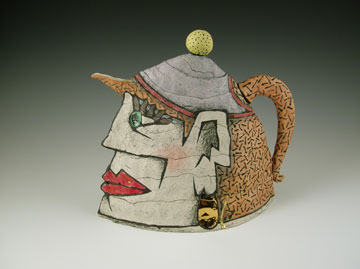July 13 - August 3, 2006
- Reception: Thursday, July 13, 6 to 8 p.m.
- Gallery talk by Ken Hoffman at 7 p.m.
- Music by Jordan Kaye and friends
 This exhibition featured the ceramic work and paintings of two seasoned and talented artists.
This exhibition featured the ceramic work and paintings of two seasoned and talented artists.
Hoffman, professor emeritus of Art from Bradley University in Peoria, has had his paintings exhibited in Paris, Germany, Poland, Australia, Ireland, and Argentina. He is currently represented by Walter Wickiser Gallery and Amos Eno Gallery, both in New York City. For the past 15 years, the anthropomorphic subject matter of his animal portrait paintings has been the central focus of his work; he strives to convey animal-people expressions, revealing to the viewer how close humans are to animals. Hoffman states that the impact of his imagery “parallels certain kinds of modern literature such as that written by Orwell, Kafka, Beckett, and others, i.e., Animal Farm, Metamorphosis, Waiting for Godot, etc. Technically, I try to achieve painterly surface effects and sensuous buildup of the paint. Color is used as a part of a complex method of mark making which is incorporated into the primary forms and surrounding spaces.”
Ceramic artist Rimas VisGirda’s characteristic drawing style developed in the late 1970s and early 1980s (Ceramics Today). The Lithuanian-born American’s well-exhibited ceramic work is a combination of wheel-thrown and hand-built clay, manipulated further with a variety of surface treatments that leave his stylized caricatures reveling in thick eyelashes, pouty lips, and architectural profiles. Close inspection of his cartoon-like imagery reveals scratches, lines, and the occasional fingerprints. He states that his work is influenced “by my family, the culture I live in, the machine age, the urban environment, the media, and fad and fashion. I like to show that my work is a combination of man and material where both the person making the object and the material has equal significance. I exaggerate dents and imperfections when appropriate to the construction process, as in throwing or hand building.”